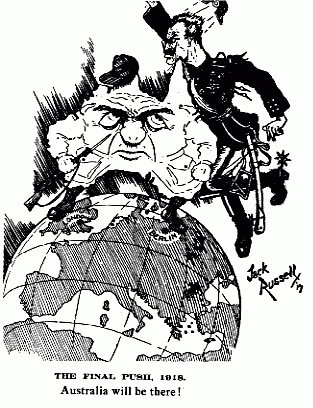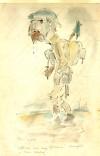1918: Australians in France - The Australian Imperial Force (AIF) in 1918
- 1918: Australians in France
- The Australian Imperial Force (AIF) in 1918

A cartoon by Jack Russell which was featured on the Australian headquarter staff souvenir Christmas card in 1917.
By 1918, the First World War had been in progress for over three years, and thousands of Australians had already been killed or wounded. Possibly every Australian town had experienced a loss of one or more of their community. For the Australians, since the transport of the first battalions in 1914, the main battle theatre had been in the Middle East - Turkey, Palestine and Egypt. There, until their evacuation from Gallipoli in 1916, Australian and New Zealand soldiers had earned a reputation for their skill and determination, often in terrible conditions. These troops - the Australian and New Zealand Army Corps - became known as the Anzacs. Anzac Day - 25 April - has become Australia's annual commemoration of war dead, and a tribute to those who served.
In 1916, Australian troops - then consisting of four divisions - were moved to the fighting fronts of France and Belgium. They became heavily involved in the combined Allied effort offensive around the Somme River, which aimed to break through the German defence lines and thus end the war. However, attempts failed, and during the next two years, Australian and Allied troops were to experience some of the most deplorable conditions and destructive battles of the war. Fighting was for the most part conducted from lines of trenches that spanned thousands of miles. This resulted in an arena of war which was often muddy, cold, waterlogged, lice - and rat-ridden, and littered with bodies.
Many of these battles on the Western Front, such as the Battle of the Somme in 1916 or Passchendaele in 1917 (with over 38,000 Australian dead or wounded), were wasteful and ill-conceived conflicts. Hundreds of thousands of men on both sides of the struggle were killed and wounded, often for no clear gains. Nevertheless, throughout all this suffering, the men of the AIF gained a reputation for reliability, competence and skill - a reputation that was to be greatly consolidated throughout 1918. About 117,000 Australian men were in France at this time, constituting about one-eleventh of the overall British armies.
As well as the servicemen of the army, navy and flying corps, many other kinds of personnel made up the AIF, such as medical personnel and chaplains. All made crucial and significant contributions to the war effort, and to the importance and quality of Australia's participation in the First World War.
At the beginning of 1918, there was a feeling that the year would be a decisive one, yet there was no assurance that it would be the last year of the war.
Three years of fighting and destruction had failed to produce any clear victors. The various commanders of the Allied armies all had different ideas of how the war would be won, and each was confident that his plan for 1918 was superior. Initially, however, there was a sense that Germany held the trump card and would launch a massive offensive in the spring. The Russian front had collapsed and Russian forces were in confusion following the October 1917 Russian Revolution, allowing Germany to redeploy troops from that front for a final assault on the Western Front. In Belgium, the fruitless Flanders campaigns had greatly weakened British offensive capability, and troops were exhausted after the debacle of Passchendaele. Sections of the French army were still recovering from a bout of mutinies in mid-1917.
As for the Australian troops, over the winter of 1917-18 the then five Australian divisions were reorganised into an Australian Corps, initially commanded by General William Birdwood, but eventually replaced by Lieutenant General John Monash. Brigadier General Thomas A. Blamey, was appointed Monash's Chief of Staff. The troops then began a much-needed period of rest, retraining and restructuring.
On 31 December 1917, on the verge of the new year, Australian Corporal Robert Addison wrote:
This is the last day of the year, and may the New Year bring the end of this terrible war, and so end so much suffering and bring Peace and Happiness all over the world.
Though many undoubtedly shared his view, there were still many fresh Australian recruits eager to enter into battle, with a feeling that their efforts could win the war.
The Royal Australian Navy
At the end of the First World War, the Royal Australian Navy was just seven years old. Many ships had been away for a long time: HMAS Australia, the RAN's first flagship, sailed for war in 1914 and did not return to an Australian port until May 1919. Australian ships saw extensive service and did significant work protecting ports and coastlines, keeping the trade routes open, enabling the passage of troops, and directly engaging the Imperial German Navy. At the time of the armistice, ten RAN ships were in northern waters, including three- Australia, Melbourne, and Sydney - that were serving in the Royal Navy's Grand Fleet.
The Australian Light Horse
Often depicted as the archetypal soldiers of the young Australian nation, the mounted men of the Light Horse rode across biblical lands and fought on ancient battlefields. During the Gallipoli campaign in 1915, the Light horse fought as infantry. While some light horsemen then went on to France as divisional mounted troops, twelve regiments remained to serve in the Middle East. Light Horsemen took part in the defence of Egypt and in the fighting in the Sinai desert. Before taking part in the strenuous campaign against the Turks in Palestine and Syria, they were organised into the Desert Mounted Corps and placed under the command of an Australian, Lieutenant General Sir Harry Chauvel. They eventually entered Jerusalem and were the first Allied troops to enter Damascus, on 1 October 1918, shortly before the enemy's surrender.

Isn't there any flaming droughts in this country?
By Will Dyson- a cartoon that captured the weariness of trench life surrounded by rain and mud.
A scene in the dust at Lejjun (Megiddo) during the advance on Damascus, showing the Australian Light Horse advancing and prisoners by the wayside, September 1918

